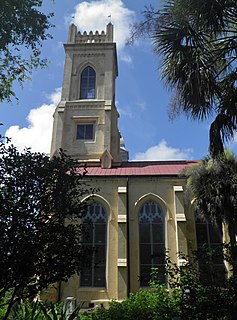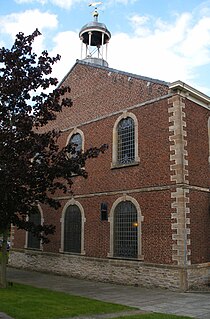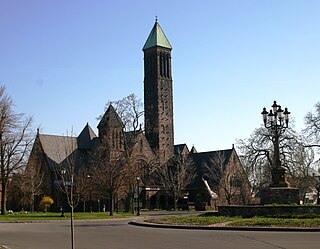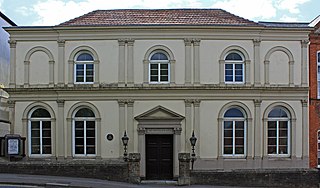
Toxteth Unitarian Chapel is in Park Road, Dingle, Liverpool, Merseyside, England. Since the 1830s it has been known as The Ancient Chapel of Toxteth. It is recorded in the National Heritage List for England as a designated Grade I listed building. and continues to be in use as a Unitarian chapel. It is a member of the General Assembly of Unitarian and Free Christian Churches, the umbrella organisation for British Unitarians.

Ullet Road Church is a Unitarian church at 57 Ullet Road, Sefton Park, Liverpool. Both the church and its attached hall are separately recorded in the National Heritage List for England as designated Grade I listed buildings. It was the first place of worship in the United Kingdom to register a civil partnership for a same-sex couple. It is a member of the General Assembly of Unitarian and Free Christian Churches, the umbrella organisation for British Unitarians.

The Arlington Street Church is a Unitarian Universalist church across from the Public Garden in Boston, Massachusetts. Because of its geographic prominence and the notable ministers who have served the congregation, the church is considered to be among the most historically important in American Unitarianism and Unitarian Universalism. Completed in 1861, it was designed by Arthur Gilman and Gridley James Fox Bryant to resemble James Gibbs' St. Martin-in-the-Fields in London. The main sanctuary space has 16 large-scale stained-glass windows installed by Tiffany Studios from 1899 to 1930.

The Unitarian Church in Charleston, home to a Unitarian Universalist congregation, is an historic church located at 4 Archdale Street in Charleston, South Carolina. It is the oldest Unitarian church in the South and the second oldest church building on the peninsula of Charleston.

Upper Chapel is a Unitarian chapel on Norfolk Street in Sheffield City Centre. It is a member of the General Assembly of Unitarian and Free Christian Churches, the umbrella organisation for British Unitarians. The Chapel is Grade II listed.

Dean Row Chapel is a Unitarian place of worship in Cheshire, North West England. It is located 2 miles (3 km) east of the town of Wilmslow, Cheshire, near the junction of the A5102 and B5358 roads. The structure is recorded in the National Heritage List for England as a designated Grade II* listed building. The congregation is a member of the General Assembly of Unitarian and Free Christian Churches, the umbrella organisation for British Unitarians.

Baptist Chapel, Great Warford is located in Merryman's Lane in the village of Great Warford, Cheshire, England. It is recorded in the National Heritage List for England as a designated Grade II* listed building.

Chowbent Chapel is an active Unitarian place of worship in Atherton, Greater Manchester, England. It was built in 1721 and is the oldest place of worship in the town. It is a member of the General Assembly of Unitarian and Free Christian Churches, the umbrella organisation for British Unitarians. The chapel was granted Grade II* Listed status in 1966.

The First Presbyterian Church in Buffalo, New York was the first organized religious body formed in what was then the western frontier of New York State. The town of Buffalo was sparsely populated when the church was organized on February 2, 1812. However, having survived the War of 1812, the town of Buffalo was rebuilt and rapidly grew with the completion of the Erie Canal in 1825. The first two buildings were located on the same downtown lot. However, the congregation relocated between 1889 and 1891 to its present location approximately one and-a-half miles to the north in a more residential area.

Rivington Unitarian Chapel is an active place of Unitarian worship in Rivington, Lancashire, England. It was founded in 1703, although its congregation dates to 1667. It is designated as a Grade II* listed building with some restoration in 1990.

First United Methodist Church is a historic church at 129 W. Hutchison in San Marcos, Texas.

The Wesleyan Methodist Church, also known as the Wesleyan Chapel, is a former Wesleyan Methodist church on Hospital Street, Nantwich, Cheshire, England. Built in 1808, a new façade was added in 1876. The church then seated over a thousand, and was the largest Nonconformist place of worship in the town in the 1880s. It is listed at grade II. The church closed in 2009, after the congregation moved to the former Methodist schoolrooms opposite.

Fulwood Old Chapel is a Unitarian place of worship in the Fulwood district of western Sheffield, South Yorkshire. It is a member of the General Assembly of Unitarian and Free Christian Churches, the umbrella organisation for British Unitarians.
Bardon Park Chapel is a 300-year-old Christian meeting house at Bardon, Leicestershire, England. It stands back from the A511 road, between Coalville and Markfield, about 1.3 miles (2.1 km) west of M1 junction 22. At the time of its construction, the meeting house was set within a medieval deer park.

Billingshurst Unitarian Chapel is a place of worship in Billingshurst in the English county of West Sussex. The cottage-like building was erected in 1754 for General Baptists, hence its original name of the Billingshurst General Baptist Chapel, but the congregation moved towards Unitarian beliefs in the 19th century, and still maintain these. It is a member of General Assembly of Unitarian and Free Christian Churches, the umbrella body for British Unitarians.

Horsham Unitarian Church is a Unitarian chapel in Horsham in the English county of West Sussex. It was founded in 1719 to serve the large Baptist population of the ancient market town of Horsham—home of radical preacher Matthew Caffyn—and the surrounding area. The chapel's congregation moved towards Unitarian beliefs in the 19th century, but the simple brick building continued to serve worshippers drawn from a wide area of Sussex. It is one of several places of worship which continue to represent Horsham's centuries-old tradition of Protestant Nonconformism, and is the town's second oldest surviving religious building—only St Mary's, the parish church, predates it. English Heritage has listed the chapel at Grade II for its architectural and historical importance.

The Unitarian Universalist Church of Buffalo is an historic church complex located at 695 Elmwood Avenue, in Buffalo, New York. The building was designed by architect Edward Austin Kent in 1906. Kent died in 1912 aboard the RMS Titanic and a memorial plaque is located in the church honoring him.

Mill Hill Chapel is a Unitarian church in Leeds, West Yorkshire, England. It is a member of the General Assembly of Unitarian and Free Christian Churches, the umbrella organisation for British Unitarians. The building, which stands in the centre of the city on City Square, was granted Grade II* listed status in 1963.

Taunton Unitarian Chapel is on Mary Street, Taunton, Somerset, England. It was built in the early 18th century as a Baptist chapel, but later adopted Unitarianism. The exterior was extensively renovated in the 19th century in an Italianate style. The chapel has been designated as a Grade II* listed building.



















